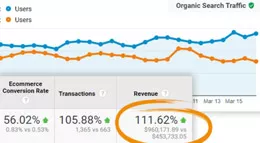6 SEO Changes You Can Make in One Hour to Improve Your Rankings
SEO is without question a marathon not a sprint, but sometimes you want to do as much as you can as fast as you can!
This post is built for you — those who want to execute basic SEO best practices as fast as possible. The tips and practices that are outlined here can be completed within a one-hour period. Without question it can be accomplished in a two-hour SEO-focused session of work.
Here are the quick wins you can accomplish today in your SEO program to drive results:

1. Validate Your XML Sitemap
Your XML sitemap is a file that lists all the pages on your site or blog, which search engines use to index them more easily. You can submit this file to Google Search Console and Bing Webmaster Tools, along with information about each page’s content type and last modified date.
You can validate your sitemap by using the free Google Sitemap tool in Search Console. The validator will also tell you if there are any errors in your markup, such as “pages”.
An example of sitemap data within Google Search Console and error indications
Add FAQ Schema to your highest traffic pages
FAQ Schema can help your website show more prominently in rich snippet listings when a user searches for a question.
FAQ schema tags work by adding a schema.org format block to the <head> section of your webpage that matches a format supported by Google search results, such as:
This helps users find your website when they are searching for facts or information related to your content or what you have on your FAQ page, and it also provides Google with the information it needs to determine how useful your page will be to a user.
An example of how FAQ Schema code renders within a standard search listing
3. Build 5 internal links to your top three URLs
Building internal links is always a great SEO practice, but it is especially important in small sites that do not have an extensive footprint of external links. Internal links can help boost your relevancy when Google crawls the page you link to and identifies the anchor text of the link (or another one of its attributes). If you have a new site, make sure to build internal links to your top three pages using relevant keywords for the anchor text.
Be sure to vary your anchor text, use keyword tools such as the Google Keyword Planner, and check your site’s link profile to avoid getting penalized by search engines for having too many exact-match anchor text links.
An example of a top target to highlight within internal linking efforts
4. Refresh the Title Tags on Your Top 10 Posts
Refreshing title tags helps SEO by making sure that the titles on your website match your current content, and it helps users by showing them which posts are new. For example, if you have three posts about finding a good pair of running shoes, make sure you update the post titles to show “Finding a Good Pair of Running Shoes (1/3)” instead of “Finding a Good Pair of Running Shoes.”
This is a very quick SEO change that can make a big difference in how your website is perceived by search engines. To get the most from this update, you should also use Google Analytics to segment your analytics data by your updated title tags. This way, you’ll know which pages had an improvement in performance and where your old title tags were bringing in traffic.
Testing and deploying large scale title tag optimizations is a great strategy for SEO at scale
5. Rewrite A Couple of Blog Posts for Better SEO
Blogs are a great way to improve your site’s organic search performance because they regularly add new content and use keywords. But blogging regularly isn’t enough – you need to make sure that each post is as successful as possible.
Try writing a couple of blog posts from scratch that will rank well for your keywords and modify older, less popular blog posts to bring them up to the same level as your new content.
A good rule of thumb is to look to update your most popular posts yearly, adding in new data from the current year, new citations and quotes as well as potentially updated graphics or illustrations. A great place to start is by leveraging tools like Answer the Public which will tell you exactly what themes and questions to integrate into your content.
An example of semantic themes to target within a post relating to “eCommerce”
6. Reach out to 10 editors in your space for guest post opportunities
If you’re not familiar with what a guest post is, it’s simply an article written by someone who is not a part of your company that you allow to be published on your website. These are usually high-quality articles written by experts in their field, which can help build trust and authority for your website.
Getting 2-5 links to a page that has been somewhat dormant in terms of rankings can sometimes make the difference between a page 2 ranking and one above the fold on page 1.







